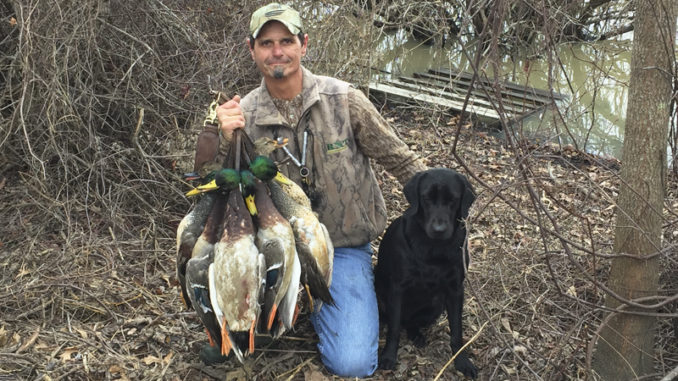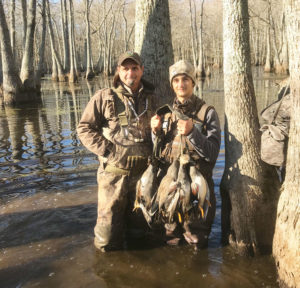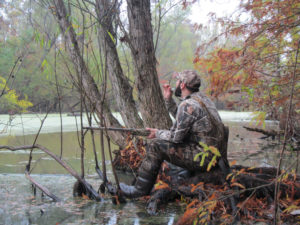
Although it’s not as prevalent as it once was in Louisiana, flooded timber still provides the state’s hunters with plenty of opportunities to fill their straps.
Warren Coco still reminisces about his days duck hunting in the swamp near Maurepas, back in the 80s and 90s when the vast network of cypress forests housed an impressive number of mallards during the winter migration.
Back then, he said he could hunt just about every day and come home with a limit.
“That was the best timber hunting in the state,” said the 64-year-old Baton Rouge native and founder of Go-Devil Manufacturers.
But after giant salvinia invaded the area in the late 90s and blanketed open water, Coco said the ducks stopped showing up.
A timber hunting fanatic, however, wasn’t going to hang up his gun that easily.
“I bought property where the Black and Red rivers meet — and I created my own timber holes,” he said.
That was back in 2003 when all Coco had was old agricultural land in Central Louisiana, situated in a floodplain known for high concentrations of wintering waterfowl.
So he planted 6,000 willow trees, along with cypress and oaks, that could be flooded seasonally to provide habitat for migrating waterfowl. Ten years later, after the fingerling trees grew, he was routinely shooting stringers of ducks on his property.

“These are some of the best timber holes,” he said. “The willows give you cover to hide in, and it also enhances the invertebrate growth for the ducks to eat.”
Those large flights of mallards once reached down to the coast as well, near Thibodaux where cypress trees covered the marsh.
Roland Cortez recalled watching groups of greenheads swirl over the trees when he was a kid. “It was a mallard Mecca,” he said. “But the habitat changed, and the ducks don’t come like that anymore.”
Due to coastal erosion and invasive aquatic vegetation, Cortez’s old hunting grounds are open marsh now, attracting more teal and gadwalls these days.
So, he turned to hunting the timber in Arkansas as a guide, and also guiding in Southwest Louisiana when the weather conditions are favorable.
“There are still good places to hunt near Monroe, and more seasonal spots in places like Sherburne, Indian Bayou and near Pierre Part,” he said.
Louisiana’s Mississippi River Alluvial Valley (MAV) was once home to a seemingly endless supply of bottomland hardwoods forest and cypress-tupelo swamps that flooded seasonally. While much of that has turned to agriculture today or has changed due to costal erosion, you can still find pockets of woods in the historical floodplain that offer superb duck hunting.
Take Coco’s haunts in Central Louisiana, for instance — only a few miles away from the Honey Brake Lodge, Catahoula Lake and a handful of wildlife management areas known for quality waterfowl hunting amongst flooded hardwoods and cypress swamps.
Public possibilities
Due to restoration efforts by the state’s Department of Wildlife and Fisheries, public lands are now boasting new acreage featuring bottomland hardwoods that can support waterfowl and other wildlife — when just a few decades ago that land was planted for crops.
Folks engaged in federal initiatives like the Wetland Reserve Program or Conservation Reserve Program, which allows landowners to return agricultural property to wetlands or forest, have also worked to enhance the habitat in the state.
Up and down the MAV, there’s still plenty of timber holes to go around. But any parcel of woods that floods in the winter, be it a slough or stand of trees in a low-lying area, can hold ducks on their way south.
“Lots of people want big, open holes, but just one fallen tree can be good enough to draw some birds in,” said Mitch McGee, a WMA biologist supervisor with the LDWF.
“When we get the right conditions — cold weather up north and rain on the landscape — we still get mallards and have good hunts.”
Find the right habitat

Finding flooded woods in the winter may not be hard — it’s about finding the right parcel that’s suitable for migrating waterfowl. The first thing to look for is a food source.
“In a cypress swamp, look for duckweed,” Cortez said. “In a river bottom with hardwoods, look for oak trees dropping acorns.”
Coco added that smartweed is another aquatic vegetation growing in swamps that is a quality source of food. On his property, he also grows sprangletop and millet.
When Coco is searching for food sources, he also keeps his eyes on the sky, analyzing the size of the trees around him.
“The short timber is easier for the ducks to get down and into shooting range,” he said. “Thick, tall timber — they’re not as responsive to come in.”
Water levels make an impact, too.
While species like gadwall and teal prefer water levels that are a few feet deep, Cortez said mallards like it shallower. And keep your eyes peeled as rains show up, which can work to quickly flood sections of woods offering new habitat.
“When we get a hard rain, it can flood an oak bottom and the ducks will show up out of nowhere,” he said.
Create movement
Movement in the timber is crucial to drawing ducks in. That’s why Coco keeps a jerk string employed all season.
“We don’t go hunting in the timber without one,” he said.
The ducks key in on ripples in the water, letting them know other birds are nearby through the trees. That, in combination with the right decoy spread, has to happen perfectly to coax in mallards.
“In the timber I put out 100 decoys,” he said. “In smaller holes, the most I use is two dozen and we’ll pick those up after every hunt. Late in the season, less decoys are better.”
When Cortez is setting up his decoys, he’s aware of two things: the wind direction and position of the sun.
“You want the ducks to land in your face,” he said. “So, you want the wind at your back. Put the decoys farther out in the hole with a few in the woods.
“And you always want to stand on the shaded side of a tree. You don’t want the sun on you. As far as camouflage — try to use the darker type like bottomland or Natural Gear.”
Keep calling simple

The weather will dictate how much calling you need to do. Cortez said on clear, blue sky days, he calls more.
“I can be very aggressive and get their attention, getting them down quicker,” he said. “On cloudier days, I still call — but not as much. Mostly, I watch the ducks to see how they will react that day because every day varies.”
Coco likens a duck’s eyes to that of a wily turkey — with keen focus on your decoys and the woods below, the wrong calling sequence can scare them off.
“Never call when ducks are looking at you,” he said. “When they turn away, hit your call hard to make them come back. When they start coming back, only use a light chuckle or quack — but not too much.”
Public timber opportunities
The LDWF manages units called greentree impoundments on several WMAs, where hardwoods can be flooded seasonally, mimicking the natural floods of the forests in the Mississippi floodplain. This gives hunters access to thousands of acres of flooded timber.
“We are on a five-year rotation where basically every fifth year we keep the woods dry to mimic natural flooding processes,” McGee said. “We also stagger flooding to inundate new areas as the season progresses.”
You can expect to find lots of wood ducks, McGee said, with mallards showing up seasonally. “Certain times of year when the weather is right we’ll have a lot of mallards,” he said. “Typically, sunny days with 15-20 mile-per-hour winds are good days to hunt.”
- Russell Sage WMA
One of the largest remaining tracts of bottomland hardwood forests in the MAV, there are 13 waterfowl management units that total almost 8,000 acres. Hunters can expect to find 2,550 acres of greentree impoundments available to hunt, surrounded by sloughs, bayous and lakes.
- Boeuf WMA
The Boeuf River borders this WMA, where the state manages around 4,000 acres of bottomland hardwood forest for migrating waterfowl and other birds — there is an 1,800-acre greentree impoundment for hunters. The numerous sloughs and bayous running through the property also offer excellent waterfowl hunting.
- Dewey Wills WMA
Opened in 2015, a 3,000-acre waterfowl impoundment north of the Catahoula Lake Diversion Canal provides excellent waterfowl hunting opportunities. In addition, there’s also the 400-acre southern waterfowl impoundment, known locally as the Greentree Reservoir.
- Richard K Yancey WMA
Located between the Mississippi and Red rivers, winter flooding inundates the woods, which are surrounded by lakes and sloughs. There’s also a 1,200-acre waterfowl impoundment that is available and seasonally flooded to support migrating waterfowl.
- Atchafalaya Basin
At almost 1 million acres of bottomland hardwoods and cypress-tupelo swamps, hunters won’t have a problem finding flooded woods in the Basin. There are opportunities on Sherburne WMA and Indian Bayou, but with several thousand acres of state-owned land dispersed around the Atchafalaya, there’s plenty to choose from.


